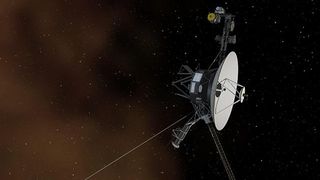From interstellar space, twin Voyager probes spot 'electron burst'
The discovery could shed new light on the mechanisms of flaring stars.

NASA's twin Voyager probes keep making discoveries in interstellar space.
The Voyager mission has detected a new type of "electron burst," which will provide insights into the mechanisms of flaring stars, a new study reports.
The bursts occur when cosmic ray electrons — fast-moving particles from far beyond the solar system — are pushed by shock waves generated by solar eruptions. The electrons then accelerate further along cosmic magnetic field lines to incredible speed, study team members said.
"The idea that shock waves accelerate particles is not new," corresponding author Don Gurnett, professor emeritus in physics and astronomy at the University of Iowa, said in a statement. "[But] we detected it in a new realm: the interstellar medium, which is much different than in the solar wind, where similar processes have been observed."
Both Voyager spacecraft are still going strong after 43 years in space, with each regularly sending back science to Earth from their remaining operating instruments. (Voyager 2 flew incommunicado for several months in 2020 due to planned repairs and upgrades to its radio communications facility here on Earth but made contact again in November.)
The first stage to creating the electron bursts happens with coronal mass ejections. These solar eruptions blast huge amounts of superhot plasma into space and create shock waves that move outward through the solar system.
These shock waves accelerate fast-moving cosmic-ray electrons, charged particles that likely originate from distant supernovas. The cosmic rays are further accelerated along magnetic field lines in between stars, in the interstellar medium.
Get the Space.com Newsletter
Breaking space news, the latest updates on rocket launches, skywatching events and more!
Voyager at 40: 40 photos from NASA's epic 'grand tour' mission
Eventually, the magnetic field lines propel the cosmic rays to almost the speed of light — nearly 670 times faster than the solar shock waves that first pushed them. (The shock waves move at roughly 1 million mph, or 1.6 million kph, study team members said.)
"Physicists believe these electrons in the interstellar medium are reflected off of a strengthened magnetic field at the edge of the shock wave, and subsequently accelerated by the motion of the shock wave," the University of Iowa said in the same release. "The reflected electrons then spiral along interstellar magnetic field lines, gaining speed as the distance between them and the shock increases."
Voyager 1 and Voyager 2 both detected the electron bursts within days of their acceleration, and somewhat later, the two probes spotted slower, lower-energy plasma wave oscillations through the interstellar medium generated by the electron bursts.
The twin spacecraft also detected the originating solar shock wave up to a year after the event occurred; the wait time happened because the spacecraft are so far from the sun. Voyager 1 is about 14.1 billion miles (22.7 billion km) away from the sun, and Voyager 2 is about 11.7 billion miles (18.8 billion km) from our star. (The average Earth-sun distance is roughly 93 million miles, or 150 million km.)
Astronomers hope to better understand how shock waves and cosmic radiation originate from flaring stars. Solar outbursts can generate radiation that poses risks for astronauts on the International Space Station or other destinations, such as the moon (where NASA hopes to land in 2024.) Particularly violent eruptions can also threaten Earth-orbiting satellites and planetary infrastructure like power lines.
The new study was published Wednesday (Dec. 3) in The Astronomical Journal.
Follow Elizabeth Howell on Twitter @howellspace. Follow us on Twitter @Spacedotcom and on Facebook.
Join our Space Forums to keep talking space on the latest missions, night sky and more! And if you have a news tip, correction or comment, let us know at: community@space.com.

Elizabeth Howell (she/her), Ph.D., is a staff writer in the spaceflight channel since 2022 covering diversity, education and gaming as well. She was contributing writer for Space.com for 10 years before joining full-time. Elizabeth's reporting includes multiple exclusives with the White House and Office of the Vice-President of the United States, an exclusive conversation with aspiring space tourist (and NSYNC bassist) Lance Bass, speaking several times with the International Space Station, witnessing five human spaceflight launches on two continents, flying parabolic, working inside a spacesuit, and participating in a simulated Mars mission. Her latest book, "Why Am I Taller?", is co-written with astronaut Dave Williams. Elizabeth holds a Ph.D. and M.Sc. in Space Studies from the University of North Dakota, a Bachelor of Journalism from Canada's Carleton University and a Bachelor of History from Canada's Athabasca University. Elizabeth is also a post-secondary instructor in communications and science at several institutions since 2015; her experience includes developing and teaching an astronomy course at Canada's Algonquin College (with Indigenous content as well) to more than 1,000 students since 2020. Elizabeth first got interested in space after watching the movie Apollo 13 in 1996, and still wants to be an astronaut someday. Mastodon: https://qoto.org/@howellspace
